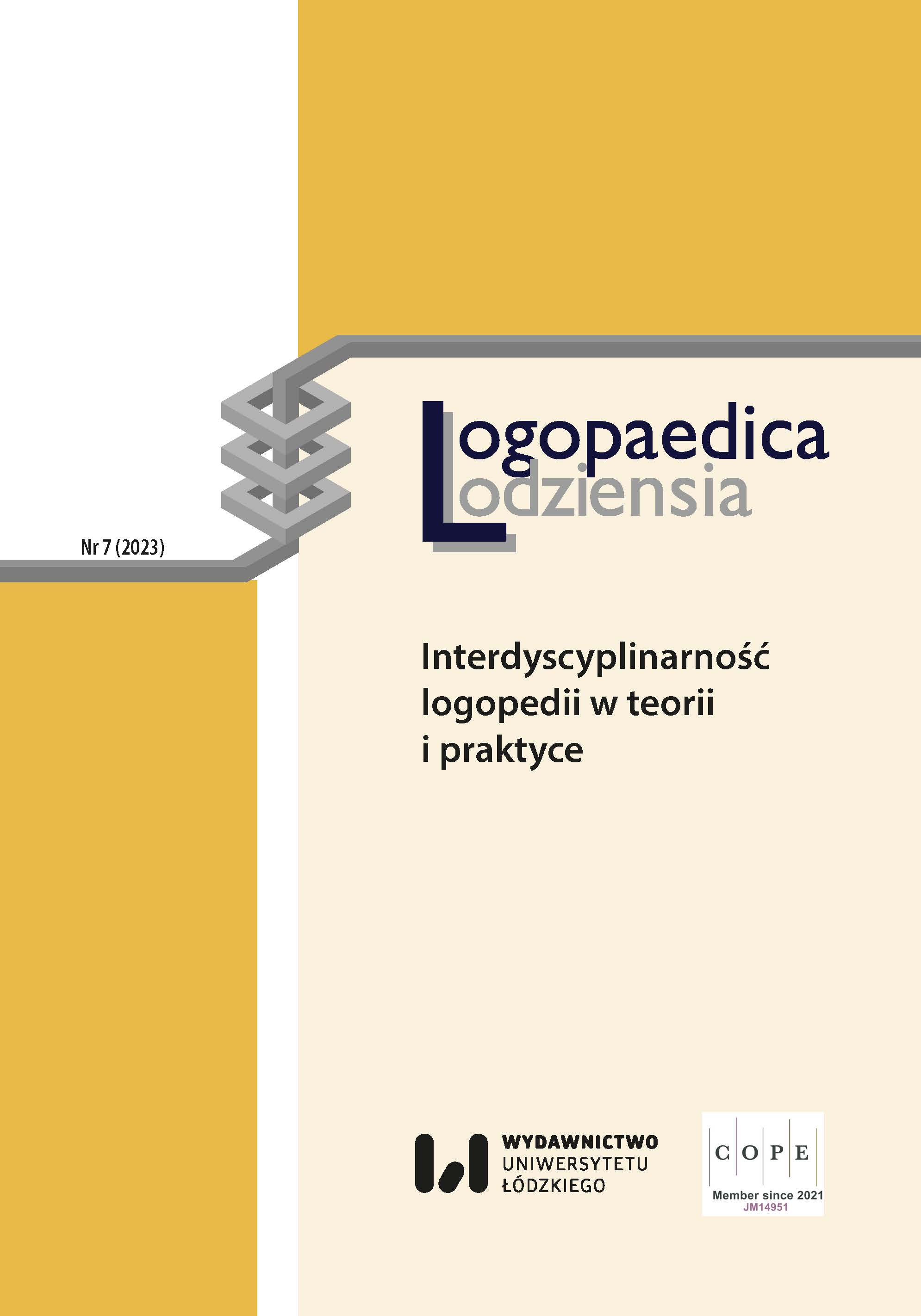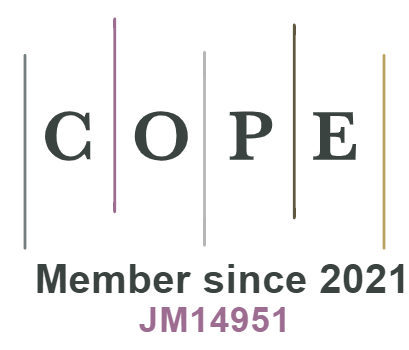A preliminary investigation of stutteringand typical disfluencies in bilingual Polish‑English adults who stutter: A multiple cases approach
DOI:
https://doi.org/10.18778/2544-7238.07.06Keywords:
Stuttering, fluency, bilingualism, dysfluency, languageAbstract
This study analyzes the frequency of stuttering and typical disfluencies in Polish‑English bilingual adults who stutter during cross‑linguistic dialogue, monologue, and oral reading contexts. Additionally, the relationship between English proficiency and stuttering and typical disfluency frequencies was examined. The study aims to contribute to the body of research regarding differential considerations between monolingual and bilinguals who stutter. Data collection took place via video conferencing. Participants first completed an English proficiency cloze test, where they entered missing words in a short English text. Following this, randomized dialogue, monologue, and oral reading speech samples in Polish and English were collected. The correlation between cloze test scores and frequency of stuttering and typical disfluency in the English samples was also examined. All participants experienced more stuttering in English (L2) than Polish (L1) during dialogue. Overall, participants had increased stuttering in L2 for at least one speaking task. Seventy one percent of participants had increased typical disfluencies in L2 for dialogue and monologue. Most participants evidenced an increase in stuttering and typical disfluencies in L2 compared to L1. The results suggest that language proficiency may share a relationship between frequency of stuttering and typical disfluencies, highlighting the importance of collecting cross‑linguistic speech data during assessment to reach clinical decisions related to fluency disorders in bilingual populations.
Downloads
References
Al’Amri F., Robb M.P., 2020, Disfluency characteristics of Omani Arabic‑English bilingual speakers, “Clinical Linguistics & Phonetics”, Vol. 35(7), pp. 593–609, https://doi.org/10.1080/02699206.2020.1806931
Google Scholar
Ambrose N., Yairi E., 1995, The role of repetition units in the differential diagnosis of early childhood incipient stuttering, “American Journal of Speech‑Language Pathology”, Vol. 4(3), pp. 82–88.
Google Scholar
Ardila A., Ramos E., Barrocas R., 2011, Patterns of stuttering in a Spanish/English Bilingual: A case report, “Clinical Linguistics & Phonetics”, Vol. 25(1), pp. 23–26.
Google Scholar
Barcroft J., 2004, Effects of sentence writing in second language lexical acquisition, “Second Language Research”, Vol. 20(4), pp. 303–334.
Google Scholar
Bernstein Ratner N., Benitez M., 1985, Linguistic analysis of a bilingual stutterer, “Journal of Fluency Disorders”, Vol. 10, pp. 211–219.
Google Scholar
Blood G.W., Hood S.B., 1978, Elementary school‑aged stutterers disfluencies during oral reading and spontaneous speech, “Journal of Fluency Disorders”, Vol. 3, pp. 155–165.
Google Scholar
Bloodstein O., 1974, The rules of early stuttering, “Journal of Speech and Hearing Disorders”, Vol. 39, pp. 379–394.
Google Scholar
Bloodstein O., Bernstein Ratner N., 2008, A handbook on stuttering, New York: Thomson‑Delmar.
Google Scholar
Brown S.F., 1938, Stuttering with relation to word accent and word position, “Journal of Abnormal and Social Psychology”, Vol. 33, pp. 112–120.
Google Scholar
Brown S.F., 1945, The loci of stutterings in the speech sequence, “Journal of Speech Disorders”, Vol. 10, pp. 181–192.
Google Scholar
Byrd C.T, Bedore L.M., Ramos D., 2015, The disfluent speech of bilingual Spanish‑English children: Considerations for differential diagnosis of stuttering, “Language, Speech, and Hearing Services in Schools”, Vol. 46, pp. 30–43.
Google Scholar
Byrd C.T., Watson J., Bedore L., Mullis A., 2015, Identification of stuttering in bilingual Spanish‑English speaking children, “Contemporary Issues in Communication Science and Disorders”, No. 42, pp. 72–87.
Google Scholar
Chae E.‑Y., Shin J.‑A., 2015, A study of a timed cloze test for evaluating L2 proficiency, “English Teaching”, Vol. 70(3), pp. 117–135.
Google Scholar
Coalson G.A., Peña D.E., Byrd C.T., 2013, Description of multilingual participants who stutter, “Journal of Fluency Disorders”, Vol. 38, pp. 141–156.
Google Scholar
Dworzynski K., Howell P., 2004, Cross‑linguistic factors in the prediction of stuttering across age groups – The case of German, [in:] A. Packman, A. Meltzer, H. Peters (eds.), Theory, research and therapy in fluency disorders. Proceedings of the 4 World Congress on Fluency Disorders, Montreal: International Fluency Association, pp. 382–388.
Google Scholar
Dworzynski K., Howell P., Natke U., 2003, Predicting stuttering from linguistic factors for German speakers in two age groups, “Journal of Fluency Disorders”, Vol. 28(2), pp. 95–112.
Google Scholar
Eggers K., Van Eerdenbrugh S., Byrd C., 2020, Speech disfluencies in bilingual Yiddish‑Dutch speaking children, “Clinical Linguistics & Phonetics”, Vol. 34(6), pp. 576–592, https://doi.org/10.1080/02699206.2019.1678670
Google Scholar
Evans D.L., 2002, The adaptation effect in bilingual people who stutter: An examination of the oral‑motor rehearsal theory, Master thesis, Maine: University of Maine, https://digitalcommons.library.umaine.edu/cgi/viewcontent.cgi?article=1292&context=etd (accessed: 15.08.2022).
Google Scholar
Gahl S., 2020, Bilingualism as a purported risk factor for stuttering: A close look at a seminal study (Travis et al., 1937), “Journal of Speech, Language, and Hearing Research”, Vol. 63, pp. 3680–3684.
Google Scholar
Grosjean F., 1998, Studying bilinguals: Methodological and conceptual issues, “Bilingualism: Language and Cognition”, Vol. 1, pp. 131–149.
Google Scholar
Grosjean F., 2004, Studying bilinguals: Methodological and conceptual issues, [in:] T. Bhatia, W. Ritchie (eds.), The Handbook on Bilingualism, Oxford: Blackwell Publishing Company, pp. 32–63, http://doi.org/10.1002/9780470756997
Google Scholar
Hernández‑Jaramillo J., Velásquez‑Gómez K., 2015, Patterns of stuttering comparing two languages: A case report, “Revista Ciencias de la Salud”, Vol. 13(3), pp. 493–504, https://doi.org/10.12804/revsalud13.03.2015.09
Google Scholar
Hollebeke L., Neyt J., 2013, Stotteren en tweetaligheid. Een onderzoek naar het verschil in type en frequentie van stottergedrag en andere niet‑Vloeiendheden, Unpublished Master Thesis, Gent: Universiteit Gent.
Google Scholar
Howell P., Ruffle L., Fernandez‑Zuniga A., Gutierrez R., Fernandez A.H., O‘Brien M.L., Tarasco M., Vallejo Gomez I., Au‑Yeung J., 2004, Comparison of exchange patterns of stuttering in Spanish and English monolingual speakers and a bilingual Spanish‑English speaker, [in:] A. Packman, A. Meltzer, H. Peters (eds.), Theory, Research and Therapy in Fluency Disorders. Proceedings of the 4 World Congress on Fluency Disorders, Montreal: International Fluency Association, pp. 415–422.
Google Scholar
Hubbard C.P., Prins D., 1994, Word familiarity, syllabic stress pattern, and stuttering, “Journal of Speech and Hearing Research”, Vol. 37, pp. 564–57.
Google Scholar
Jankelowitz D.L., Bortz M.A., 1996, The interaction of bilingualism and stuttering in an adult, “Journal of Communication Sciences and Disorders”, Vol. 29, pp. 223–234.
Google Scholar
Jayaram M., 1983, Phonetic influences on stuttering in monolingual and bilingual Stutterers, “Journal of Communication Disorders”, Vol. 16, pp. 287–297.
Google Scholar
Johnson K.N., Karrass J, Conture E.G., Walden T., 2008, Influence of stuttering variation on talker group classification in preschool children: Preliminary findings, “Journal of Communication Disorders”, Vol. 42(3), pp. 195–210.
Google Scholar
Kashyap P., Maruthy S., 2020, Stuttering frequency in Kannada‑English balanced bilingual adults, “Clinical Linguistics & Phonetics”, Vol. 34(3), pp. 271–289.
Google Scholar
Kobayashi M., 2002, Cloze tests revisited: Exploring item characteristics with special attention to scoring methods, “The Modern Language Journal”, Vol. 86(4), pp. 571–586.
Google Scholar
Kohnert K., Medina A., 2009, Bilingual Children and Communication Disorders: A 30 Year Research Retrospective, “Seminars in Speech and Language”, No. 30, pp. 219–233.
Google Scholar
Krawczyk A., 2018, A Crosslinguistic Analysis of Stuttering and Typical Disfluencies in Polish‑English Bilinguals Who Stutter, Master’s thesis, Orlando: University of Central Florida.
Google Scholar
Lim V .P.C., Lincoln M., Chan Y.H., Onslow M., 2008, Stuttering in English‑Mandarin bilingual speakers: The influence of language dominance on stuttering severity, “Journal of Speech, Language, and Hearing Research”, Vol. 51, pp. 1522–1537.
Google Scholar
Maruthy S., Raj N., Geetha M.P., Priya C.S., 2015, Disfluency characteristics of Kannada‑English bilingual adults who stutter, “Journal of Communication Disorders”, Vol. 56, pp. 19–28.
Google Scholar
Morrish T., Nesbitt A., Zsilavecz U., 2017, Sounds affecting moments of stuttering in multilingualism: A case study, “Communication Disorders Quarterly”, Vol. 38(3), pp. 154–160.
Google Scholar
Oller J.W. Jr., 1972, Scoring methods and difficulty levels for cloze tests of proficiency in English as a second language, “The Modern Language Journal”, Vol. 56(15), pp. 1–158.
Google Scholar
Pawlusiewicz M., 2001, Piękna nasza Polska cała, Warszawa: Wisdom Publishers Corporation.
Google Scholar
Roberts P.M., 2002, Disfluency patterns in four bilingual adults who stutter, “Journal of Speech Language Pathology”, Vol. 26(1), pp. 5–19.
Google Scholar
Schäfer M., Robb P., 2012, Stuttering characteristics of German‑English bilingual speakers, “Clinical Linguistics & Phonetics”, Vol. 26(7), pp. 597–612.
Google Scholar
Sunbathing (n.d.), In Actual press magazine 486, Cover story, Mag & Fl@sh. Centre d’animation en langue.
Google Scholar
Travis L.E., Johnson W., Shover J., 1937, The relation of bilingualism to stuttering: A survey of the East Chicago, Indiana, schools, “Journal of Speech Disorders”, Vol. 2(3), pp. 185–189.
Google Scholar
Tremblay A., Garrison M., 2010, Cloze tests: A tool for proficiency assessment in research on L2 French, [in:] M.T. Prior (ed.), Proceedings of the 2008 second language research forum, Somerville: Cascadilla Proceedings Project, pp. 73–88.
Google Scholar
Van Borsel J., Maes E., Foulon S., 2001, Stuttering and bilingualism: A review, “Journal of Fluency Disorders”, Vol. 26, pp. 179–205.
Google Scholar
Van Borsel J., Sunaert R., Engelen S., 2005, Speech disruption under delayed auditory feedback in multilingual speakers, “Journal of Fluency Disorders”, Vol. 30(3), pp. 201–217.
Google Scholar
Werle D.R., Byrd C., Coalson G., 2019, Description of multilingual participants who stutter: An update 2011–2018, “Communication Disorders Quarterly”, Vol. 41(1), pp. 50–57.
Google Scholar
Downloads
Published
Versions
- 2023-12-01 (2)
- 2023-11-29 (1)
How to Cite
Issue
Section
License

This work is licensed under a Creative Commons Attribution-NonCommercial-NoDerivatives 4.0 International License.












